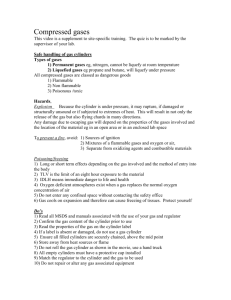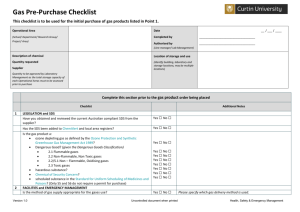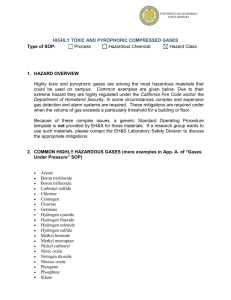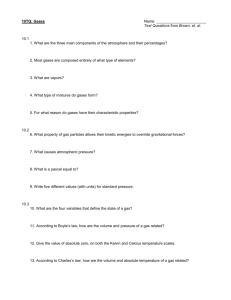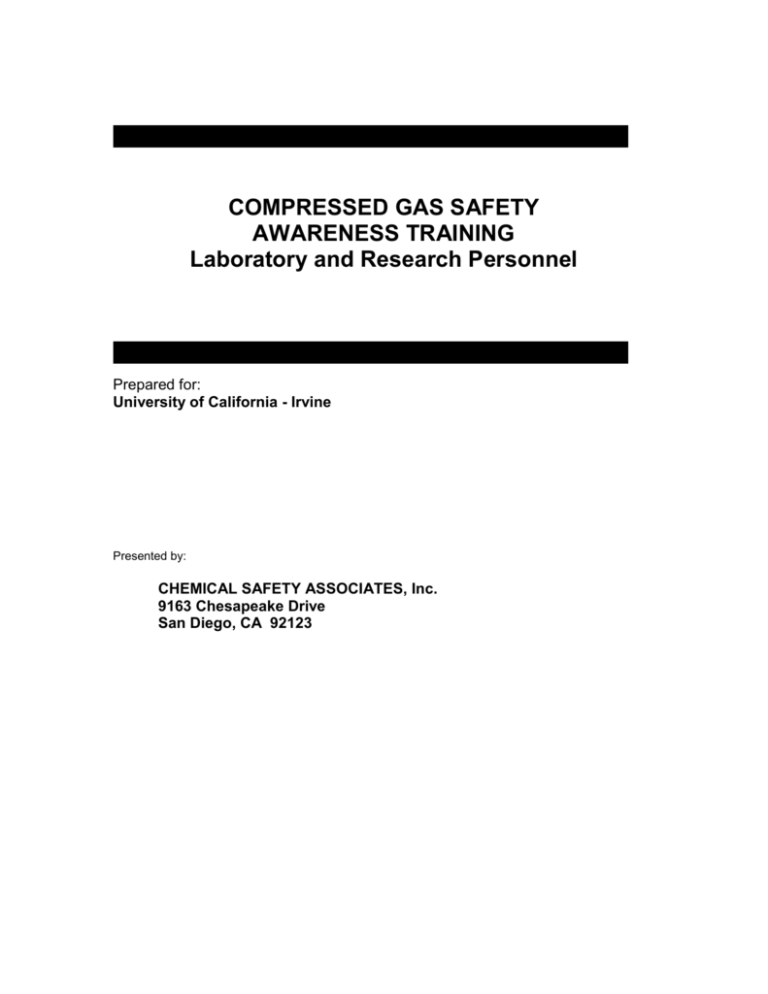
COMPRESSED GAS SAFETY
AWARENESS TRAINING
Laboratory and Research Personnel
Prepared for:
University of California - Irvine
Presented by:
CHEMICAL SAFETY ASSOCIATES, Inc.
9163 Chesapeake Drive
San Diego, CA 92123
COPYRIGHT INFORMATION
COMPRESSED GAS SAFETY - AWARENESS TRAINING is provided as a service to the
hazardous materials industry. Copyright © 1996 by CHEMICAL SAFETY ASSOCIATES, Inc.
all rights reserved. Printed in the United States of America. No part of this manual may be
reproduced, stored in a retrieval system, or transmitted in any form or by any means,
electronic, mechanical, photocopying, recording, or otherwise, except for the use of the
University of California - Irvine Campus for campus training or Companies and individuals who
obtain written permission directly from CHEMICAL SAFETY ASSOCIATES, Inc.
San Diego, CA 1996
INTRODUCTION
Compressed gases are used in many locations on the UCI Campus. The gases are
used for research and for maintenance. The Campus is required to provide training to all
employees who handle gases related to their jobs. This Awareness Training will help
inform you of potential hazards associated with the gases used on Campus. As a result of
this training, you will have specific information needed to prevent accidents. You will learn
how to safely handle and use various gases found on the campus, and where to go to obtain
more information. Finally, you will learn what to do in the event of an emergency.
WORKSHOP
In the space below, list five compressed gases you commonly handle, and their major
hazard(s).
COMPRESSED GAS
MAJOR HAZARD(s)
Regulations
Special regulations have been developed related to compressed gases. Cal/OSHA
has regulations that directly affect safety. Among these are special regulations for
flammable and some toxic gases. Various local Fire Codes, including the Irvine City Fire
Code and the Orange County Fire Code and various Building Codes impact use and storage
of compressed gases. Perhaps the single most significant regulation is the “San Jose Model
Ordinance”. The code has not been adopted in Irvine, but is so useful for any location
handling semiconductor process gases, that it should be routinely adopted.
THE PHYSICAL STATES OF COMPRESSED
There are three physical states commonly associated with gases used in industry.
*
*
*
Gaseous (Non-liquefied),
Liquefied, and
Dissolved.
Descriptions and examples of each of these three states are given in the following
paragraphs.
NON-LIQUIFIED COMPRESSED GAS
A non-liquefied compressed gas is a gas that is completely in the gas state at 70º F,
at its charged pressure. Nitrogen, oxygen, air, helium and hydrogen are examples of nonliquefied compressed gases. The quantity of gas in the container is directly proportional to
the pressure.
LIQUIFIED GAS
A liquefied gas is a gas, which at its charged pressure is partially liquid at 70°F.
Many gases, when pressurized, will condense and liquefy at ambient temperature
conditions. In fact, most compressed gases are liquefied gases. Water vapor provides an
excellent demonstration of this phenomenon. If water vapor at 212°F is contained at
atmospheric pressure or above, the steam produced starts to condense back to water.
Different materials have varying boiling points and will condense at different pressures.
CRYOGENIC GASES
Cryogenic gases are special cases. Cryogenic gases are brought to very low
temperatures while being compressed. Cryogenic gases will remain in the liquid state only
if low temperatures are maintained.
DISSOLVED GAS
A dissolved gas is a gas dissolved in a solvent. Currently, only one gas is shipped in
a dissolved state; Acetylene is usually dissolved in acetone because acetylene is unstable in
the free state. Cylinders carrying acetylene contain a filler material such as diatomaceous
earth, which is wet with acetone, into which the acetylene is dissolved.
HOW THE PHYSICAL STATE OF A GAS AFFECTS HANDLING
The physical state of a gas will play a significant role in how the gas is handled. For
example, liquefied gases do not conform to the standard pressure-volume-temperature
relationships of gases. The pressure in a cylinder of liquefied gas is defined as the vapor
pressure of the liquid, and is dependent solely upon the temperature. If we increase the
temperature, the pressure will rise, but not in proportion to the absolute temperature, as with
a non-liquefied gas. The pressure-temperature relationships of any liquefied gas are solely a
unique property of the material under consideration. In most cases, the vapor pressure will
have a very steep rise relative to the temperature, much more so than would be expected if
the gas were a non-liquefied gas. The table, below, shows those gases that are shipped as
non-liquefied and liquefied under normal room temperature conditions.
NON-LIQUIFIED GASES
Air
Argon
Carbon Monoxide
Fluorine
Helium
Hydrogen
Methane
Neon
Nitrogen
Oxygen
Silane
Nitric Oxide
LIQUIFIED GASES
Ammonia
Arsine
Butane
Carbon Dioxide
Chlorine
Dichlorosilane
Ethane
Halocarbon 12 (Freon 12)
Hydrogen Chloride
Hydrogen Fluoride
Hydrogen Sulfide
Monomethylamine
Methyl Chloride
Nitrogen Dioxide
Nitrous Oxide
Phosgene
Phosphine
Propane
Sulfur Dioxide
Sulfur Hexafluoride
Vinyl Chloride
HAZARD CLASSIFICATIONSCLASSIFICATIONS
The potential hazards associated with compressed gases provide definitive reasons
for special training in routine handling and emergency response procedures. The following
properties summarize the most common hazards potentially faced while handling
compressed gases.
PRESSURE HAZARDS
Pressure represents the potential energy inherent in a compressed gas if it is released
suddenly. Once released, this potential energy becomes kinetic energy. This kinetic energy,
when released, can cause extensive property damage and may present a serious health
problem physically and chemically.
Although failure of the gas container itself is possible, containers usually rupture
from improper filling techniques, corrosion, or entrapment in a fire. When properly
handled, the likelihood of cylinder failure by those containers obtained from reputable
suppliers is extremely small. However, all compressed gases must be considered pressure
hazards.
FLAMMABILITY
A gas is considered flammable by the Department of Transportation if a mixture of
13% or less (by volume with air) forms a flammable mixture, or if the flammable range with
air is greater than 12%, regardless of the lower limit when measured at atmospheric
temperature and pressure. Hydrogen, acetylene, methane are all examples of flammable
gases.
TOXICITY
Toxic gases adversely affect the health of those exposed to them. The toxicity of
gases ranges from extreme (causing death or severe injury after a short-term contact with
them) to slight (causing irritation). Hydrogen cyanide, hydrogen sulfide, phosgene, and
carbon monoxide are examples of toxic gases.
CORROSIVITY
A corrosive gas causes destruction of living tissue by chemical action or causes
serious degradation of common construction materials. These gases are toxic to some
degree and are usually very irritating, particularly to the eyes and mucous membranes.
Hydrogen bromide, boron trichloride, and hydrogen chloride are examples of corrosive
gases.
ASPHYXIANT HAZARDS
Asphyxiation results when a gas displaces air and reduces the concentration of
breathable oxygen. Almost all gases are asphyxiates. Gases that pose chiefly asphyxiation
hazards include nitrogen, argon, and neon.
OXIDIZERS
Oxidizers are those gases that will support combustion, usually at a rate much
greater than that of air. Oxygen, nitrous oxide, and chlorine are examples of gases that are
oxidizers.
PYROPHORIC MATERIALS
Pyrophoric materials are substances that are spontaneously flammable in air.
Pyrophoric gases include silane, diborane, and phosphine.
HIGHLY REACTIVES GASES
Highly reactive gases, such as fluorine, chlorine, nitrogen dioxide, nitrosyl chloride,
and interhalogens (such as chlorine trifluoride or bromine pentafluoride) require special
handling techniques. They are extremely active oxidizers and are usually classified as such.
OTHER HAZARDS
Every gas falls into one or more of the hazard categories mentioned above. In
addition, many gases can be obtained as radioactive isotopes with the inherent risk of
radiation exposure. Although radioactive gases are not as common as the standard gases,
those working with them should take all the necessary precautions for handling radioactive
chemicals and recognize the diffusion problem if material escapes.
RULES FOR HANDLING
COMPRESSED GASES
SAFELY
IDENTIFY CYLINDER & CHEMICAL CONTENTS
Read shoulder label and all tags to identify chemical
Review MSDS and other Gas Data Sheets
Do not use unknown gases
Determine maximum possible pressure from tank markings
USE GOOD ENGINEERING PRACTICES
Secure cylinder firmly
Leave valve protection cap in place until ready to use cylinder
Use designated regulator and support equipment
Use materials that are compatible with the gas
Do not use oil or grease on any gas handling fittings or equipment
Determine if there are special requirements with regard to temperature, pressure, moisture, or air sensitivity and
engineer the system to control these requirements
Place explosion barriers around all glass or plastic gas handling equipment
Use correct CGA fittings
Do not use adapters
Provide electrical grounding for all flammable gas systems
Position systems so as not to block routes of escape
Use fixed point and portable monitors as needed
FOLLOW PROPER GAS HANDLING PRACTICES
Flush corrosive gas systems with inert gas when not in use
Passivate reactive or corrosive gas systems
Develop written Standard Operating Procedures for gas use
Include Emergency Response procedures in written SOP
Leak test all toxic gas cylinders prior to acceptance
Only use toxic gases in gas cabinets or fume hoods
STORAGE
Only store the quantity of gases you will need for one week operation
Store all gases in a cool, secure location
Use appropriate leak detection systems and methods
Minimize cylinder inventory
SAFETY RULES FOR USE OF COMPRESSED PROCESS GASES
(SSA Journal p 18, 1988)
GAS SUPPLY
1.1
Only process gases provided with certificates of purity should be used.
1.2
Cylinder suppliers should vent all residual purge gases from returned empty
cylinders in a safe manner.
1.3
Suppliers should ensure that cylinders are properly prepared before refilling. There
is to be no re-use of residual product.
1.4
Suppliers should use filling systems dedicated to compatible gases.
1.5
Return cylinders in the same condition as received. Cylinders with valve outlet
plugs (Dust Caps) should have the plug installed and tight. The valve protective cap should
be installed prior to returning the cylinder from its point of use to its storage location.
SYSTEM DESIGN
2.1
All piping systems should be fabricated to meet CCI specifications approved
standards. Verify that no cross connections, other than at acceptable locations, or single
point failure that creates cross connections exist. (An example of an "Acceptable Location"
is the discharge point within a reaction chamber.)
2.2
Process and control equipment should be designed so that no single point failure can
allow premature mixing of incompatible gases prior to the point of use.
2.3
Provide systems that do not contain single point failures that could allow diversion
of flow of incompatible gases back to the cylinder source.
2.4
Some considerations for complying with 2.2, 2.3, and 2.4 are:
2.4.1 Each process gas, or type of gas, should be provided with an independent purge gas
source/cylinder. This dedicated system should be used in lieu of "House Gas" systems for
purge purposes.
2.4.2 Each purge gas source cylinder should be equipped with an approved regulator and
relief valve.
2.4.3 Provide silane systems with dedicated vents to safe location. Vents should be
continuously purged with inert gas to avoid flashback and plugging.
2.4.4 Each purge gas source should be provided with at least one check valve between the
purge gas source cylinder and the purge gas inlet control valve. (Check valves should be
inspected periodically for performance.)
2.4.5
Purge gas cylinders should be located inside an exhausted cylinder storage cabinet.
2.4.6 Use dedicated vacuum sources instead of "House Vacuum" when vacuum assisted
purging is required.
2.4.7 In addition to regulators at the process gas source, regulators should be provided on
the gas delivery line at the point of use.
2.4.8 Excess pressure relief devices should be provided at the gas source on the lowpressure side of the primary control regulator. Relief venting should be directed to a safe
location. (Pressure sensor, high-pressure shut-off technology may be considered in place of
venting.)
2.4.9 Equipment manufacturers should provide leak checks, process monitors, interlocks,
and fail-safe controls that detect failure of critical components in each process tool.
2.4.10 Check valves should not be relied upon as the sole means to prevent the back-flow of
reactive gases.
TRAINING and OPERATION
3.1
Train all personnel in systems operations, including:
Operator Personnel, Maintenance Personnel, Emergency Response Personnel
3.2
Provide supervisory overview for process gas systems.
3.3
Provide a self-inspection and audit program to ensure that established safety
systems and practices are maintained.
GAS CYLINDERS AT USER LOCATIONS
4.1
Users should notify vendors when possible contamination of process gas cylinders
occurs at the user site by providing specific information to include the cylinder serial
number, contents, pressure, and a person to contact at the user facility of use. This
information should be attached to the cylinder valve and be followed up with direct
communication between the user and the supplier.
4.2
Suppliers should not accept the return of residual gases in cylinders where the
required shipping documents are not provided.
4.3
Segregate both empty and full cylinders. Treat empty cylinders as if they were full.
FACTS ABOUT SELECTED SEMI-CONDUCTOR PROCESS GASES
GAS
ARSINE
PHOSPHINE
GERMANE
HYDROGEN
SELENIDE
SILANE
MAJOR HAZARDS
EXTREMELY
TOXIC
FLAMMABLE
EXTREMELY
TOXIC
FLAMMABLE
EXTREMELY
TOXIC
FLAMMABLE
EXTREMELY
TOXIC
FLAMMABLE
PYROPHORIC
COLOR
NONE
NONE
NONE
NONE
NONE, WHITE
SMOKY FIRE
ODOR
GARLIC LIKE
DEAD FISH
PUNGENT
NAUSEATING
TLV, ppm
ODOR THRESHOLD
RANGE, ppm
DANGER LEVEL
TARGET ORGANS
0.05
0.1
0.3
0.02 -2.6
0.2
----
ROTTEN EGG
PUNGENT,
IRRITATING
0.05
0.0004 - 3.3
~10
~100
BLOOD CELLS
KIDNEYS
LUNGS, EYES,
LIVER
PHYSIOLOGICAL
EFFECTS - ACUTE
ABDOMINAL PAIN, VERTIGO,
NAUSEA,
WEAKNESS,
VOMITING
CRAMPS,
TREMORS
HEMOLYSIS,
KIDNEY FAILURE,
ANEMIA
RESPIRATORY
DISTRESS,
NAUSEA
THERMAL BURNS
EYE
INFLAMMATION
HEADACHES &
NAUSEA
DELAYED EFFECTS
2 - 24 HRS
ppm
BLOOD CELLS
KIDNEYS
RESPIRATORY
DISTRESS,
ANEMIA
4 - 6 HRS
12 - 48 HRS
>12 HRS
BLOODY URINE
JAUNDICE
KIDNEY FAILURE,
LIVER, HEART
DAMAGE
FIRE/EXPLOSION
HAZARD
LEL/UEL
0.5
---~1000
RESPIRATORY
DISTRESS, CNS
DIFFICULTY,
PULMONARY
EDEMA
ppm
FIRE IS MAIN
HAZARD
LUNG, KIDNEY
FAILURE
BLOODY URINE
JAUNDICE
KIDNEY FAILURE
CNS COLLAPSE
SIMILAR TO
HYDROGEN
AUTOIGNITION
TEMP 212F
EXPLODES ABOVE
330C
4%/74% FOR
HYDROGEN
4%/74% FOR
HYDROGEN
0%/100%
MAY EXPLODE IN
CONTACT WITH
HALOGENS OR
OXYGEN. DO NOT
USE HALON FIRE
EXTINGUISHERS
SOLUBLE
SOLUBLE
CAN CAUSE
SEVERE EXPLOSION
UNDER SOME
UNDEFINED
CONDITIONS
COMMENTS
REACTIVITY WITH
WATER
ppm
CELLULAR
OXIDASE SYSTEM
NONE
DISSOLVES
READILY
COMA
PULMONARY
EDEMA
PYROPHORIC GAS
NO DATA,
PROBABLY
SOMEWHAT
SOLUBLE
RAPIDLY
HYDROLYZED TO
SiO2

